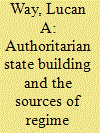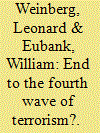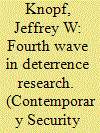| Srl | Item |
| 1 |
ID:
065239


|
|
|
| 2 |
ID:
097165


|
|
|
|
|
| Publication |
2010.
|
| Summary/Abstract |
It is widely believed that the current wave of religiously inspired terrorism will persist for the foreseeable future. Is this necessarily the case? This article asserts that this present wave may be cresting, much like previous waves in the modern history of terrorist violence. Further, the article goes on to forecast not an end to terrorism in general, but the likely emergence of still new manifestations of terrorist violence.
|
|
|
|
|
|
|
|
|
|
|
|
|
|
|
|
| 3 |
ID:
095490


|
|
|
|
|
| Publication |
2010.
|
| Summary/Abstract |
Following the end of the Cold War and accelerating after 9/11, a new wave of research on deterrence has emerged. Building on an earlier characterization by Robert Jervis, this work is here designated the fourth wave. The fourth wave reflects efforts to grapple with the change from a relatively symmetrical situation of mutual deterrence that characterized the Cold War to the asymmetric threats that dominate the current security environment for the United States and many other states. Despite widespread doubts that have been expressed in public about whether the most threatening actors today are deterrable, the fourth wave is nearly unanimous in finding that deterrence remains relevant, even with respect to terrorism. Beyond this basic consensus, the fourth wave also includes vigorous debates, particularly regarding alternative strategies for dealing with WMD-seeking rogue states. Because few analysts expect deterrence to be foolproof, especially in dealing with non-state actors, much of the work has focused on finding ways to improve the prospects for deterrence at the margins. Overall, the most important result of the fourth wave has been to reveal the value of moving toward a broader concept of deterrence that incorporates non-nuclear and even non-military sources of leverage. Proposals to use information and discourse as bases for deterrence are especially innovative and worthy of further research.
|
|
|
|
|
|
|
|
|
|
|
|
|
|
|
|
| 4 |
ID:
154411


|
|
|
|
|
| Summary/Abstract |
The concept of deterrence can be simply explained as the use of threat
to convince others to desist from initiating some course of action. A
threat serves as a deterrent to the extent that it convinces its adversary
not to carry out the intended action because of the exorbitant costs and
losses that it would incur. A policy of deterrence generally refers to threats
of military retaliation directed by one state to another in an attempt to
prevent the other state from resorting to the threat of use of military force
in pursuit of its foreign policy goals. In this context, as long as nuclear
weapons are around, even in small numbers, deterrence is the safest policy
to deal with them. This was true during the Cold War, and it appears to
be even truer today
|
|
|
|
|
|
|
|
|
|
|
|
|
|
|
|